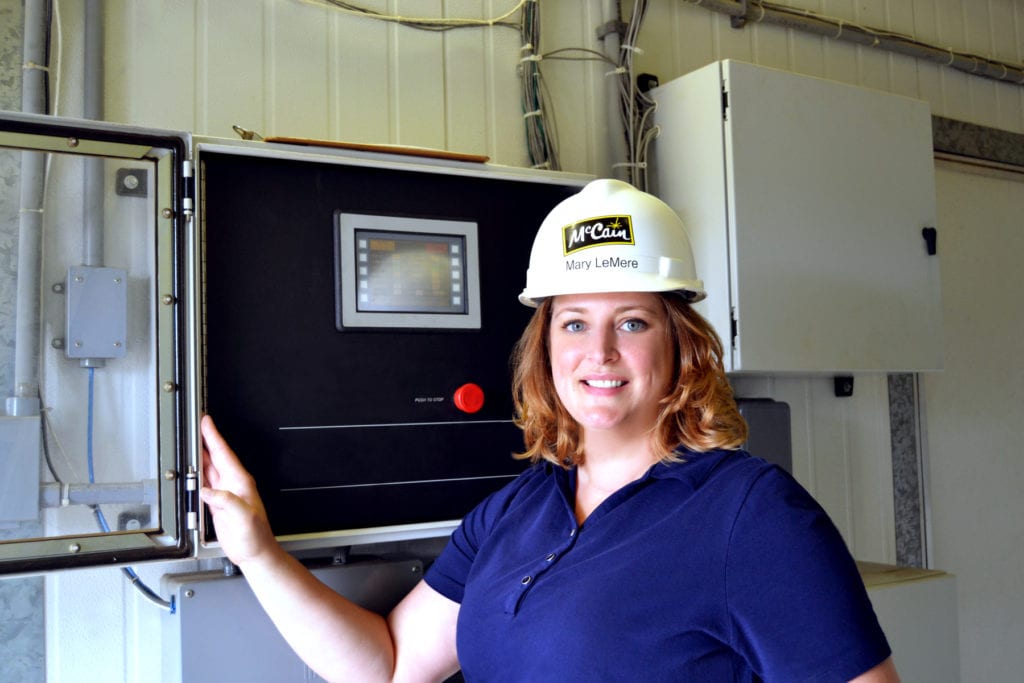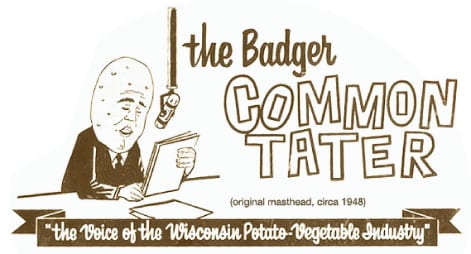
No matter how you like your French fries and whether you cook them yourself from frozen or order these golden, delicious treats at a restaurant or fast-food drive-thru, they probably originated from potatoes processed at McCain Foods USA.
McCain Foods USA’s parent company, McCain Foods Limited, a privately owned Canadian company established in 1957, is the world’s largest producer of frozen French fries and other potato specialty items. McCain Foods produces one-third of all the fries consumed in the world, churning out potato products at 1,000,000 pounds per hour, which are sold in over 160 countries.

Based on 2014 sales, McCain Foods Limited is the 19th largest private company in Canada, according to The Globe and Mail’s “Report on Business.” The company employs more than 17,000 employees and operates 43 plants on six continents including Wisconsin-based operations in Appleton, Fort Atkinson, Plover and Rice Lake.
While some of McCain Foods’ immense hundredweight of potatoes go directly to processing, many more are stored in optimum climates to facilitate year-round processing. Additionally, some products, like the curly fry, require a ‘pre-conditioning’ stage to enhance maturity.
Handling the harvest and storage aspects of this sheer volume in potatoes requires an expert logistics manager like Mary LeMere, Field Rep-Storage Tech since 2013 for McCain Foods USA, Plover branch, who was selected as the feature interviewee this month to discuss our primary theme this issue: storage.
Many of you may recognize LeMere’s name from the many articles she contributed while serving as Hancock Agricultural Research Station’s Assistant Superintendent-Storage Manager. While there, LeMere also conducted numerous storage research projects pertaining to potato, field corn, soybean, snap bean, carrot, cucumber and sweet corn vegetable crops.

At Hancock, she managed the daily operation of Wisconsin Potato & Vegetable Association’s (WPVGA) Storage Research Facility, supervising bin loading and unloading, monitoring storage quality, seed handling and cutting, chemical applications, storage sanitation and equipment and facility maintenance. She also oversaw equipment upgrades and replacements to improve potato handling and reduce storage losses.
In her present position at McCain Foods USA, LeMere oversees loading activities, executes facility improvements and develops/implements standard operating procedures and communication protocols for all McCain-Plover harvest and storage functions.
Please describe your storage facilities in Wisconsin and some of the innovations involved in these facilities especially in the areas of air circulation, temperature and humidity management.
The purpose of any process potato storage program is to provide quality raw material reliably throughout the year.
McCain Foods has a combination of storage design types; all are heavily insulated and have modern computerized control systems. Several are air envelope type buildings.
Recently McCain Foods has invested in upgrading ventilation, refrigeration, and heating systems as well as enhancing flooring and drainage for all our storages.
By simultaneously augmenting the climate control systems while boosting ventilation capacity we are providing more consistent distribution of air flow, temperature and humidity throughout our large storage buildings. Consistent environmental control is essential to preserving raw quality all year long.

Do you consult with an agricultural engineer, familiar with the construction of potato storages, when building a new potato storage facility or renovating an older facility and what other factors do you consider?
Yes. The storage improvement plan at McCain Plover has been a joint effort involving the McCain Agriculture Team, McCain Engineering Group and several professional storage systems contractors.
John Walsh, Associate Principal Scientist for McCain Global Agronomy in Florenceville, New Brunswick, and I have been leading the project. John serves as our international expert in storage design and management and has spent a considerable amount of time in Wisconsin this past year assisting with the assessment of our storage facilities.
What storage conditions and quality standards do your current and potential growers agree to when contracting with you on potato crops?
At McCain Foods, our minimum standards include a ventilation capacity of one CFM per cwt, R-30 insulation packages, steel frame structure, humidity application systems, computerized control systems and refrigeration.

We recommend variable frequency drives and use them in our long-term storages.
Provided harvest is accompanied by favorable weather and low disease pressure, McCain Foods will condition potatoes two to four weeks post-harvest at between 55 to 60 degrees, apply one cfm of air flow and 90 to 95% humidity levels to maintain processing quality.
Following this conditioning process, we will cool slowly about one to two degrees per week to an ultimate holding temperature of 47- 48 degrees. Less favorable harvest conditions require more intense care and management to achieve proper longer-term storability.
McCain Foods also conducts a thorough annual summer wash-down cleaning of storages and ventilation equipment after they are emptied. Our storage areas are audited for cleanliness annually via our participation in the USDA Good Agriculture Practices program.

Contract growers must be vigilant daily storage managers. Preventing conditions that may lead to pressure bruising, soft or dry rot, tuber dehydration and dark fry color in the finished product are all major concerns to potato processers.
What varieties do you contract for and what challenges do you face with each variety in storage?
McCain Foods works mostly with russet-type processing potatoes. The primary varieties currently used include Russet Burbank, Umatilla Russet, Ranger Russet and Innovator.
We also have a history of variety development and always have a few new varieties in small field trials for factory process testing.
Each variety we work with comes with its own set of challenges. McCain Food’s Agronomy and Field Departments work together to thoroughly trial and prove these new varieties for processing acceptability.
Bruising, during harvest and handling, can render potatoes into breeding grounds for microorganisms, which can spread quickly during storage and cause serious losses. What are some of the ways you suggest to prevent bruising prior to storage and to minimize pressure bruising during storage?

Management and employee training is the key to bruise prevention during harvest operations and throughout the storage season.
Initially, when preparing for harvest, growers should make sure harvest and storage equipment are in good repair, properly padded and calibrated.
Training your team in good harvesting practices pays off by proactively getting ahead of issues, which affect your quality and storability.
During harvest, a best practice is to keep any drops from one piece of equipment to another under six inches, but less is always better. Fewer and smaller drops improve the chances of having a bruise-free crop.
Preventing pressure bruising in storage requires careful attention to relative humidity. Breakdowns of humidification systems that go uncorrected can lead to pressure bruise development later in the storage season.
What other pre-harvest and post-harvest tips can you offer growers to provide a healthier potato destined for storage?
Growing a healthy potato crop for storage requires proper handling and distribution. Handling of a crop begins before a grower even receives the first shipment of seed and continues as the potatoes are loaded into storage and eventually removed from storage.

It includes everything from proper sanitation procedures and equipment calibration to having a strong agronomic and storage management program.
We recommend regular crop scouting and testing through the growing season to sustain plant health, optimize nutrient levels, apply proper moisture, prevent disease and control insect pressure.
Appropriate management of plant stress can significantly increase the chance of producing high quality potatoes that fry with light color and store well.
Distribution is the decision-making step that determines the destination of the crop. Is a field suitable for long-term storage? Are there areas, such as low spots, sprayer tracks or diseased sections that need to be kept out of storage? Do conditions exist that require extra drying time once the crop is in storage?
Asking ourselves these questions and planning accordingly enhances the likelihood of having a successful storage year.

To avoid sprouting, many growers apply a sprout inhibitor such as Chloro-Isopropyl-N-Phenyl Carbamate (CIPC) or maleic hydrazide. Do you use either of these two inhibitors or do you prefer other alternatives for sprout control (particularly in regards to differing alternatives for specific varieties)?
McCain Foods uses only government-approved sprout control methods well within tolerance standards.
We use both of these compounds under the appropriate circumstances. We have worked diligently to reduce the amount of CIPC required though careful storage monitoring and introspective process scheduling.
This has enabled us to reduce application levels in Wisconsin by 35% in the last 10 years. In addition, McCain Foods participates in research around the globe looking for alternative sprout control products and methods.
How do you use humidity and temperature to prevent sprouting?
Sprout control in storage is a race against the clock.

Potatoes held in storage for periods up to a few months may only require proper temperature and humidity control for sprout management. Those that need to last until the following spring and summer will require additional intervention to stay sprout-free.
What steps do you recommend to avoid postharvest diseases like dry, soft and ring rot; leak; late blight and Silver Scurf prior to storage or how to treat them if detected during storage?
Avoiding postharvest disease development begins with good management practices in the field and during harvest.
Dry rot, for example, can be exacerbated in storage when tubers are roughly handled during harvest. Mechanical damage allows for entry of any number of pathogens that lead to losses in storage.

Once disease is found in storage the most effective course of action is to remove the affected portions of the storage immediately. When this is not possible, adjustments can be made to fan speed, temperature and humidity settings to delay progression of the disease for as long as possible.
MCCAIN FOODS, USA PLOVER FIELD TEAM
- Kerry Larson: Field Manager, 26 years at McCain Foods, 32 years in potato industry. Higher education – North Dakota State, home state – North Dakota.
- Daniel Snyder: Senior Field Representative/Raw Scheduler, 20 years at McCain Foods, 20 years in potato industry. Higher education – University of Idaho, home state – Colorado.
- Doug Nelson: Agronomist, 20 years at McCain Foods, 25 years in potato industry. Higher education – Washington State University, home state – Washington.
-
Dave Stephens and Laura Bahn Wornell inspect potatoes at the Mortenson Brothers Farm. Laura Bahn Wornell: Field Representative, five years at McCain Foods, five years in potato industry. Higher education – University of Wisconsin, home state – Wisconsin.
- Mary LeMere: Field Representative/Storage Technician, two years at McCain Foods, 10 years in potato industry. Higher education – University of Wisconsin, home state – Wisconsin.
- Tani Crego: Accountant, four years at McCain Foods, four years in potato industry. Higher education – University of Wisconsin, home state Wisconsin.
- Harold “Howie” Marceau: Field Department Lead, 30 years at McCain Foods, 33 years in potato industry. Home state – California/Wisconsin.
- David Stephens: Field Representative, brand new at McCain Foods, 20+ years in Agriculture. Higher education – Vermont Technical, home state – Vermont.
- Amy Guza: Ag Intern, three months at McCain Foods, four years in Agriculture Industry. Higher education – Michigan State University, Home state – Michigan.



